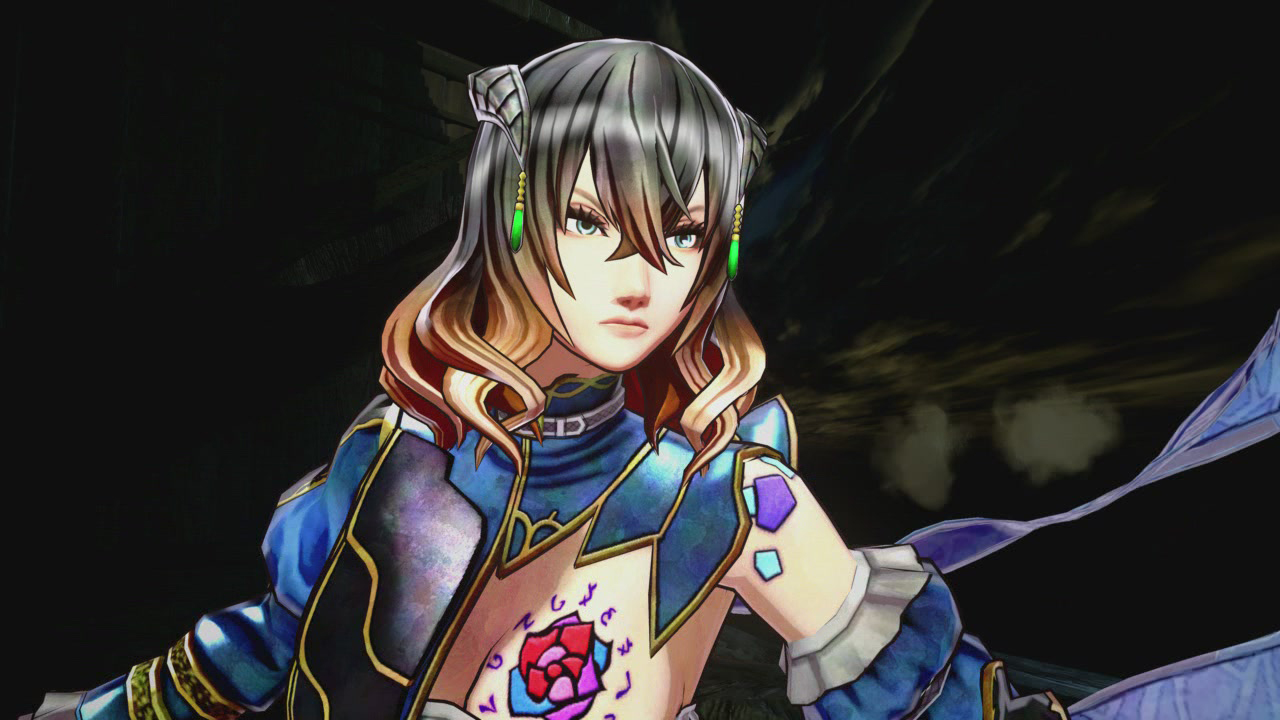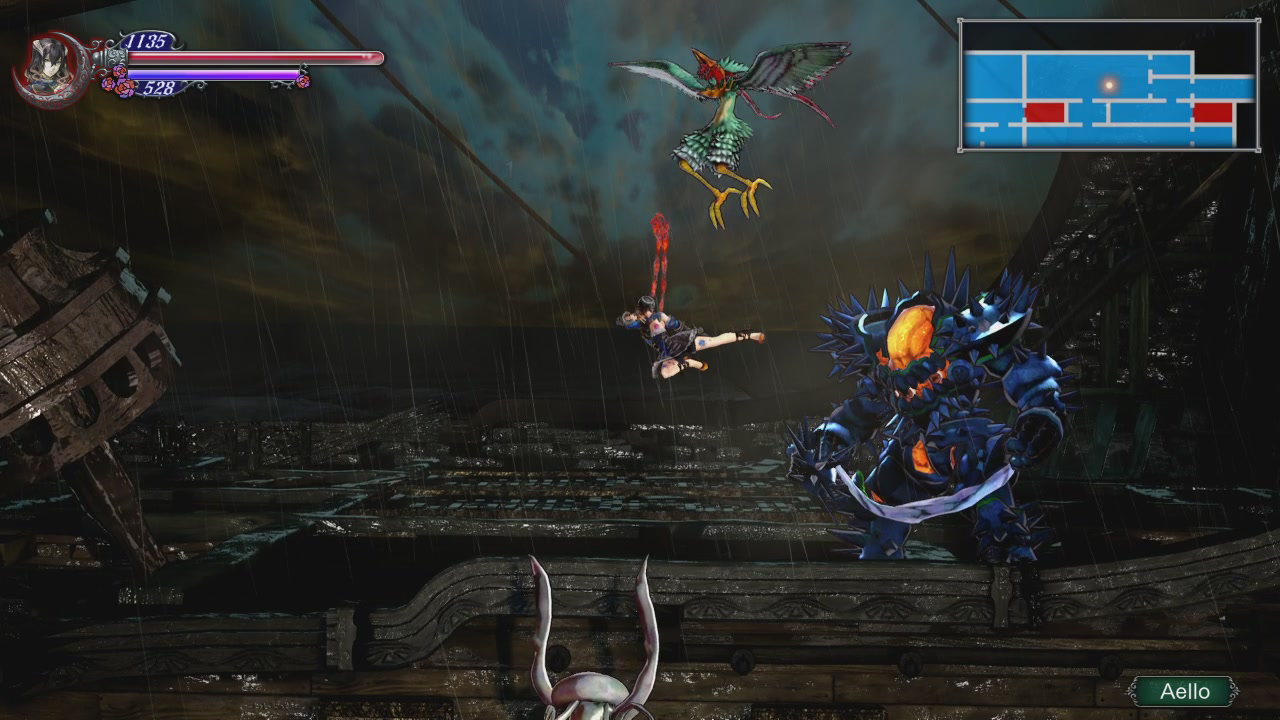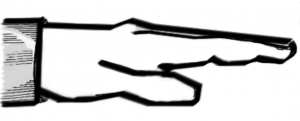[Review] Bloodstained: Ritual of the Night
The shards that enemies drop give you a source of their power if you’re able to be lucky enough for a drop from one of them. You’ll naturally acquire more throughout the story as you beat bosses which will usually give you shards as you’ll need their powers to do some puzzles and get to certain areas. But with the myriad powers at your disposal, it leaves the game open to many skill sets and combos that’s a feast for the eyes. From lighting your enemies ablaze to spawning pets to creating lightning strikes as you learn to dash, backstep, and double jump – on top of weapons which all have their own stats and elementals – it makes for a fun, flashy time letting the demons of Hellhold know that this is your territory. All of this may seem like a lot for those that may not be familiar with the genre or even at first glance, but it’s all fairly streamlined, and the combat is easy to pick up with a simple button input that can be intertwined with other assigned spells and techniques. For those that would like to get much more intricate, move sets can be acquired by reading books and tomes spread throughout Hellhold. The biggest misfortune here is that not all animations are fluid and can feel very choppy at times, but overall it’s an awesome experience that’s forgiven despite its lack of fluidity. If you’re able to master some of the techniques you learn, combat can be made even more exciting.
As if the combat and exploration doesn’t already make for a great time in Bloodstained: Ritual of the Night, longtime Castlevania composer Michiru Yamane helms the score, and I mean it when I say this game would not have been what it is without her ineffable compositions adventuring the way through with you. Every area of the castle feels distinct, with each boss memorable due in part to the ferocious yet equally beautiful sonata painting the fight, each as anthemic as the last. You could blindly fast-travel to a location and immediately know where you were the moment the associated piece began to play, and none of them ever get old. It’s all complementary to one another, making Bloodstained’s entire excavation feel whole by the end the moment the credits roll. Hearing some tracks borrowed from Curse of the Moon but this time fully orchestrated is wonderful and fits so well. The tracks transform much like the castle does as you go from theme to theme, finding yourself in a cathedral one moment, filled with organs, sustained violas and the like, before the next section takes you to a lava-filled hellscape where up-tempo drums double kick their way through guitar solos and staccatos almost as if cheering Miriam and giving her the energy to fight and protect.
Taking on all of the side quests in addition to the main game took me the better part of about 18 hours, including a complete map. Completionists looking to uncover the entirety of the map as well as acquiring every item, weapon, shard, and so on are looking at an easy 30-40+ hours depending on how the RNG treats you and proficiency. New Game+ is also available after beating the game as well as unlocks for the Hard and Nightmare difficulties to those who dare, allowing for a potentially faster, albeit much harder, go around to test all that you’ve learned now that you’ve uncovered the map.
There’s no doubt Bloodstained: Ritual of the Night has a stunning art direction, but the game isn’t particularly graphically demanding. Having initially played and beat it on an Xbox One X (where it was having plenty of performance issues) before attempting to do it all over again because I love Bloodstained that much, it was unfortunately just that on Switch: an attempt. Riddled with frame drops and poor overall presentation, Bloodstained – a beautiful game with tons of stained glass aesthetic – becomes hard to look at, with washed out colors, mushy textures and heavy input lag. It also runs at half the speed of other platforms while still retaining the same overall issues they do as well. While 60 frames could sometimes drop down to the high 40s and be immediately noticeable, on Switch it caps out at 30 on a good day, and with the same performance issues in similar locations of Hellhold it can go down to extremely poor numbers. Audio is muffled similar to some LEGO titles with heavy compression, and in some conversations the background would disappear entirely instead of blurring out. When it did attempt to load the background when conversations would occur, patterned blocks filled with image noise would substitute the void, making for an odd and conflicting dance of colors splashed on the screen. There’s not much of a difference in visual fidelity between TV and handheld mode either, leaving for no real way to optimize the experience outside of a much-needed patch.
I was committed to playing Bloodstained again after beating it the first time on Xbox One because I genuinely fell in love with it. Bloodstained is addicting and captivating in all the right ways, with the perfect blend of RPG elements to help enhance, craft, and evolve Miriam over the course of your playthrough, but after several hours with the Switch version – in which I was ready to give up after the first twenty minutes – enough was enough and I couldn’t allow myself to go further; the game would also end up crashing on me roughly four times. Add that on top of long loading times and rough transitions from zone to zone, and Bloodstained simply feels stained on Switch. It’s heavy and feels like a chore to play through, with some areas tanking performance further and bosses having more interest in killing the hardware rather than Miriam.
With lots to do and collect, Bloodstained has tons of replay value well after you beat it, and with the genuine surprise I’ve had playing it, I sincerely hope we see Bloodstained grow and evolve into a healthy, long-lasting series to take place of the dormant Castlevania series. Miriam is a great character and those you meet along the way also leave a lasting impact. It’s unfortunate the Switch version is such a disappointment, and I hope those reading this can give it the time of day on another platform if you have the means to do so. It’s absolutely worth playing and buying at full price, but the Switch version needs to be heavily avoided for now until it gets patched to Hellhold and back. Igavania is alive and well, but the Switch version is in need of intensive care.
The Verdict
Bloodstained: Ritual of the Night is a brilliant game that goes back to the Igavania of old, giving us the classic gameplay and progression Igarashi has been made famous for and bringing it to the modern day with quality of life enhancements and tons of throwbacks. At the same time, it’s able to introduce new players to a fresh property that hopefully grows into something much more, and can help expose new players to what’s made these games thrive for so long. The game can sometimes become grueling, but it is incredibly rewarding to see every boss go down, even if some may seem cheap or a little over the top. Bloodstained isn’t without fault, however, being inconsistent with performance throughout. It’s a fantastic game that deserves tons of praise and thankfully, after multiple delays over several years, has lived up to – and in some cases exceeded – expectations, but I advise any and all Switch owners to keep the current technical issues in mind, because this is a game that should absolutely be enjoyed to its fullest potential. This isn’t just a simple resolution drop that’s easily forgivable – it’s suffering in many areas and I feel anyone who plays it this way is doing a massive disservice to themselves. Here’s hoping that future patches improve the experience.
Bloodstained: Ritual of the Night review copy provided by 505 Games for the purposes of this review.



